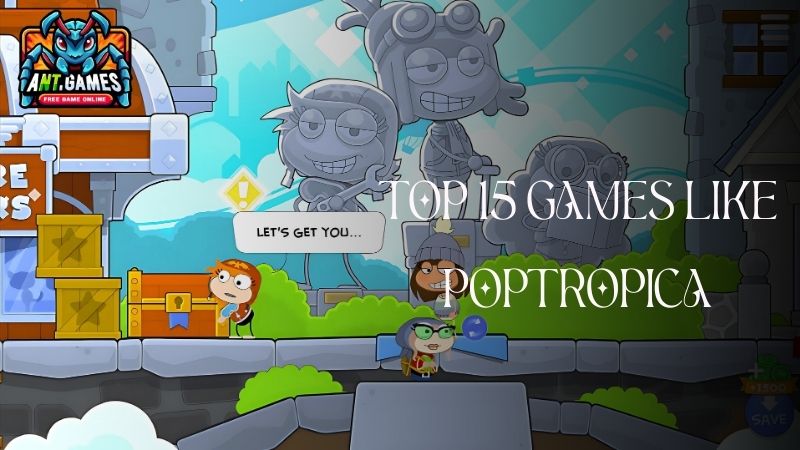A flash game, also known as a browser game, is an online computer game that can be played directly through a web browser.
These browser-based interactive experiences revolutionized digital gaming, offering instant accessibility and diverse content to millions of users worldwide. From rudimentary puzzles to intricate narrative-driven adventures, flash games epitomized a unique epoch in the evolution of video games.
While flash technology has been deprecated due to security concerns and the rise of HTML5 and WebGL, its impact on modern gaming persists. Many contemporary indie games and mobile applications draw inspiration from the simple yet engaging mechanics popularized by flash games.
In this article, we’ll dive into all aspects of Flash Games, discussing their origins, how they function, the reason for Flash games’s closure.
What Is A Flash Game?
A flash game is a type of computer game played over the Internet using a web browser. Flash games are typically free-to-play and require no additional software beyond a web browser with Flash capabilities.
Many multiplayer flash games emphasize social interaction on a large scale, enhancing the community experience. Due to their accessibility, these games are often played in shorter, more frequent sessions than traditional computer games, making them ideal for quick gaming breaks.

What was the first Flash Game?
The first Flash game is difficult to pinpoint, but FutureSplash Animator from 1996 is often considered a precursor. Adobe Flash enabled a new wave of web-based games, introducing titles like Stick Cricket and Alien Hominid that captivated global audiences. Flash technology allowed for varied genres, from action games to educational content, and empowered independent developers to reach wide audiences without costly hardware.
As Flash evolved, it introduced new game mechanics and subgenres such as tower defense and idle clickers, establishing browser-based gaming as accessible and popular. Despite Flash’s decline due to security issues and the shift to HTML5, its influence on game design and digital content remains significant.

The History of Flash Gaming
Flash gaming has played a pivotal role in the evolution of online gaming, shaping the culture of interactive entertainment during its peak.
- The Beginning (1990s): Flash gaming traces its roots to 1996 with the introduction of Adobe Flash (originally FutureSplash Animator). This technology enabled interactive animations and games on the web, marking the start of an era for simple yet engaging browser-based games.
- Growing Popularity (Early 2000s): In the early 2000s, Flash games gained momentum, driven by platforms like Newgrounds and Miniclip. These sites fostered a vibrant community of indie developers, allowing them to create and share games easily, without needing advanced programming skills.
- The Golden Age (Mid-2000s): The mid-2000s represented the peak of Flash gaming, with iconic titles like Line Rider and Bloons. Developers used ActionScript to create more sophisticated games, leading to an explosion of creativity and innovation in the community.
- The Decline (2010s): Flash gaming began to decline around 2010 due to the rise of HTML5, Unity, and mobile gaming. Major browsers phased out Flash support, citing security concerns, and Adobe announced the end of Flash Player support in 2020.
- Preservation Efforts:As Flash’s discontinuation loomed, preservation projects like Flashpoint emerged to archive thousands of games, preserving Flash gaming’s legacy for future generations. Despite its decline, Flash gaming remains influential in the world of indie game development.

How do Flash games work?
Flash games, once a cornerstone of web-based entertainment, , worked by leveraging Adobe Flash Player, a multimedia platform. This platform allowed developers to create interactive content using ActionScript, Flash’s programming language. Developers would design games by combining vector graphics, animations, and sound, then writing the game’s logic in ActionScript. The game itself was saved as a .SWF (Small Web Format) file, which contained the code, visuals, and audio. When a player visited a website with a Flash game, the browser would load the SWF file, and the Flash Player plugin would interpret and run the game directly within the browser. Player input, such as mouse clicks or keyboard presses, would trigger specific actions in the game, like character movement or interactions with objects, all of which were controlled by the code written in ActionScript.
The charm of Flash games lies in their accessibility and instant entertainment, offering users a quick, enjoyable escape without traditional gaming barriers. This accessibility fostered a community of indie developers and a robust ecosystem of user-generated content.

Why did the flash game shut down?
Why was Flash replaced by HTML5?
The transition from Adobe Flash to HTML5 in web development and online gaming was driven by several critical factors. While Flash had its advantages, HTML5, an open web standard, offered superior cross-platform compatibility across devices and browsers, which is one reason why HTML5 is better than Flash.
HTML5 games provided faster load times, reduced CPU usage, and smoother gameplay experiences. Security vulnerabilities in Flash exposed users to malware and cyberattacks, whereas HTML5 offered a more secure environment.
As smartphones and tablets became widespread, Flash’s inability to run on most mobile devices limited its reach. In contrast, HTML5 was designed with mobile compatibility as a core feature, allowing for responsive games and applications that worked across desktops, tablets, and smartphones.

Can I play Flash games without Flash?
Yes, it is possible to play Flash games without Flash. While HTML5 has largely replaced Adobe Flash, you can still enjoy many classic Flash games through emulators like Ruffle and BlueMaxima’s Flashpoint. These tools allow you to play Flash games across different browsers without the original plugin.
Many Flash games have also been reimagined using HTML5, WebGL, and other modern web standards, making them accessible on mobile devices. Additionally, some projects offer downloadable Flash game archives for offline play.
Despite the transition to newer technologies, Flash games continue to thrive through these alternatives, allowing you to revisit the golden era of browser-based gaming.

What are Flash Games From Back In The Day?
What are Best Selling Flash games?
The golden era of Flash games introduced iconic titles that captured millions of players worldwide. While traditional sales metrics don’t apply to free-to-play Flash games, popularity and engagement indicate top-performing titles.
Games like ‘Line Rider,’ ‘Fancy Pants Adventures,’ and ‘Alien Hominid’ stood out for their innovative gameplay and viral spread. These browser-based games shaped casual gaming, with titles like ‘Stick RPG’ and ‘The Impossible Quiz’ still fondly remembered.
Notable Flash game hits include:
- ‘Bloons Tower Defense’ – A strategic tower defense game
- ‘Club Penguin’ – A multiplayer online game for children
- ‘Happy Wheels’ – A ragdoll physics-based obstacle course game
Though Flash technology has been discontinued, many of these games have been preserved or ported to other platforms, ensuring their legacy. The influence of Flash games can still be seen in today’s mobile gaming apps.

See More: Best flash games ever
How can I play Flash games after 2020?
Nostalgia seekers and retro gaming enthusiasts can still enjoy Flash games after 2020, despite Adobe’s discontinuation of Flash Player support. Emulator technologies like Ruffle and BlueMaxima’s Flashpoint provide platforms for running Flash games on modern operating systems. Browser extensions such as Flashpoint Infinity offer seamless integration for playing archived games.
In addition, Flash alternatives like HTML5 and WebGL have emerged, with developers porting classic Flash games to these more secure frameworks. This shift ensures Flash games remain accessible while embracing modern web technologies.
The effort to preserve Flash games not only keeps gaming history alive but also ensures access to educational and interactive content that was once dependent on Flash.

Frequently Asked Questions
Can Flash Games Still Be Played Today?
Yes. Flash game enthusiasts can still immerse themselves in nostalgic gaming experiences through meticulously curated Flash game archives and browser-based game revivals.
Embrace the autonomy to explore retro gameplay with advanced Flash emulation tools or offline Flash play alternatives. Relive those iconic gaming moments from the golden era of web-based entertainment at your convenience.
What Programming Languages Were Commonly Used to Create Flash Games?
For Flash game development, ActionScript was the primary programming language, evolving through versions 1.0, 2.0, and 3.0. Developers utilized ActionScript’s object-oriented features, event-driven architecture, and animation capabilities like tweening and frame-by-frame animation to create dynamic visuals.
Flash games were integrated with web platforms using ActionScript’s ExternalInterface class for JavaScript communication and LoadVars class for server interaction. UI design focused on intuitive controls and responsive layouts, using MovieClip objects and event listeners for interactive elements.
While ActionScript was predominant, JavaScript was also used in later years as HTML5 began to replace Flash technology.
Did Flash Games Have Multiplayer Capabilities?
Yes, flash games often featured multiplayer capabilities, allowing players to collaborate or compete in exciting, browser-based experiences. Popular multiplayer Flash games like Stick Arena and Club Penguin exemplified the potential for real-time interaction within the Adobe Flash Player environment.
These multiplayer systems ranged from turn-based mechanics to real-time gameplay, supporting genres like MMORPGs, first-person shooters, and strategy games. Features like chat functions, leaderboards, and cooperative missions enhanced the social aspect, promoting competition and collaboration among players.
These web-based diversions served as a springboard for indie developers, democratizing game creation and distribution. The platform’s simplicity allowed for rapid prototyping and experimentation, fostering innovation in gameplay mechanics and narrative techniques. Flash games, encompassing various genres from puzzle-platformers to point-and-click adventures, catered to a wide spectrum of player preferences. Play free flash games on AntGames!





